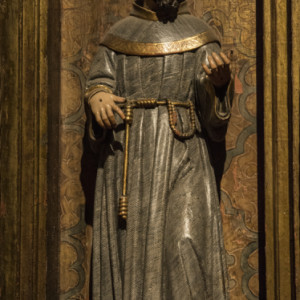Oviedo (Holiday 5/14)
Oviedo lies on one of the more traditional routes for the Camino de Santiago. I don't know if it's because of this that there wound up being a big cathedral in the city; or if the route came here because it had a serious religious centre already. Whichever way around it is, we wound up there with the day set to be somewhat wet, making a long walk feel more like a chore than a pleasing diversion.
I've mentioned before how little faith I have; or rather I do have faith, given that's all a belief in science and no pre-determinism is really, just a different branch. But I don't have faith in things that involve a total suspension of disbelief. But while it means I have no real sympathy with the guilt-driven people-control of Catholicism; I do retain a fascination with the creations wrought by that religious belief; as well as the extreme feats that people will rise to in the name of a being they fervently understand to be the truth.
The cathedral in Oviedo is the ostentation of the church writ large. The massive altar-piece is the natural focus when you walk in; but dotted around are a dozen and more smaller versions, no less intricate (though slightly less 'gold'), to numerous, now virtually unknown, saints. In front of many are little racks of LED candles, with the option of popping in a ten cent coin to light one for a period of time. A demonstration of the immense wealth of the church (as the carvings here will not exactly have been cheap to have created); combined with the call to pay to bolster your faith.
And then there come the relics. Now this I find, at equal turns, bizarre and funny and baffling. You know the kind of thing, a finger bone of St Thomas. Of which there are about 173 held in churches worldwide. Here in Oviedo there's a particularly wide and large variety of relics, from a vial of Mary's milk, to a case made by two angels (believed to be so, because they were from the east, very talented goldsmiths, and then disappeared when they finished making it).
None of 'taking this seriously' is helped when you spot Saint Francisco discovering air guitar (in the extras).
And yet. We see pilgrims, walking the Camino, marked out with scallop shells hanging from their bags. Many people do now walk the Camino for non-religious reasons (and your certificate will note that fact), but the grand majority are doing it to demonstrate their devotion or to rediscover their faith or many other reasons linked to Christianity. So while I may deride it, I cannot doubt the power of the church, and it's not my place to say that those people walking in God's name are 'wrong'. I can understand it, even if I have no desire to follow in their wake.
Two pre-Romanesque churches, high on the hill above Oviedo feel more connected to the early faith, but even then, looking at the decoration; the carved lines; the floral stone windows, from a time when people were still living in mud huts... These would have been technological marvels, architecturally astounding (especially the lower church with large columns creating verandas at each end). T'was ever thus, therefore, it would seem.
We did manage a short coast walk later in the day (spotting a fantastic wasp spider), taking in a brief section of the Camino, which by my reckoning wins us 17 seconds or so less time in purgatory; and had a fantastic Fabada lunch (after I get over one of my little language worries rears its head). Here we learn how to drink the local Asturian cider. It's a still product (or 'natural') and is usually poured by waiters from a high height, into a glass held close to the waist. It's impressive to watch (and I determine I'll never be able to master it), which creates a cloudy haze in the inch or two depth that's poured. You're then supposed to drink it immediately, in one go (leaving a small amount in the bottom that you throw away, which just seems a waste to me), wait 4 or 5 minutes, and then pour again. It's all rather time consuming for the waiters; our lunch spot has a little automatic machine on the table that recreates the aeration. A guy at a table next to us explains how to do all of this properly (otherwise I'd not have been able to write the above), and mentions that the locals don't like the machines. I guess it lacks some of the soul; and in contrast to my thoughts on religious belief, I'll happily concede that an inanimate object can be improved by a seemingly random action that can be recreated entirely convincingly by machinery.
I never claimed to be logical.


Comments
Sign in or get an account to comment.


